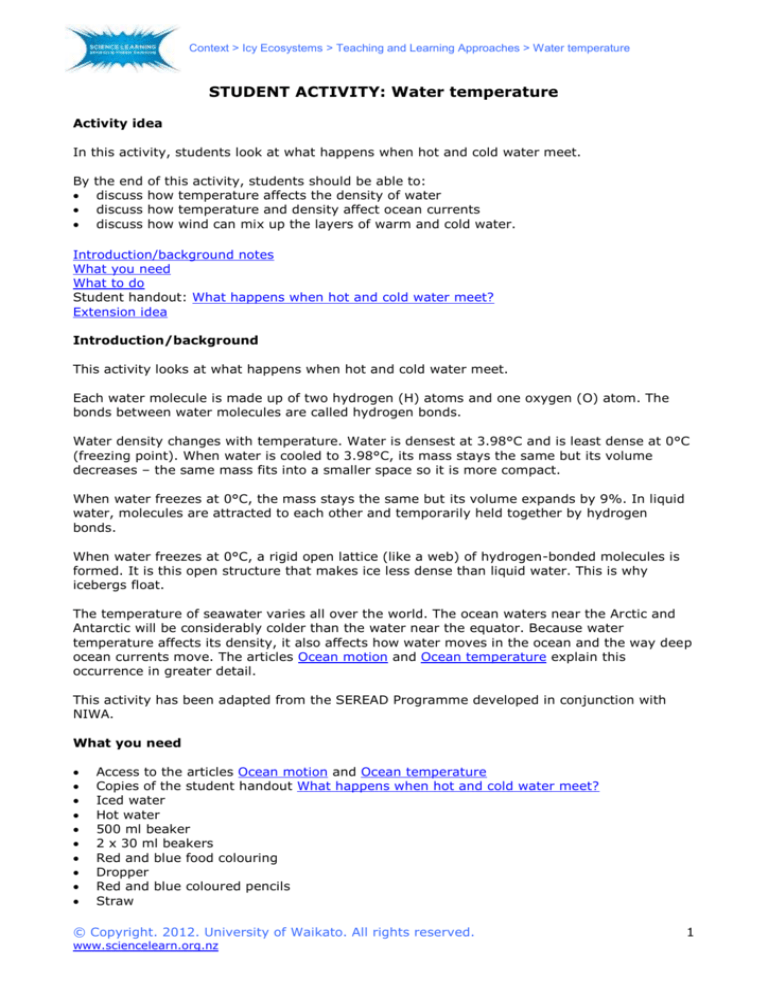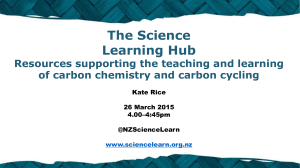
Context > Icy Ecosystems > Teaching and Learning Approaches > Water temperature
STUDENT ACTIVITY: Water temperature
Activity idea
In this activity, students look at what happens when hot and cold water meet.
By
the end
discuss
discuss
discuss
of this activity, students should be able to:
how temperature affects the density of water
how temperature and density affect ocean currents
how wind can mix up the layers of warm and cold water.
Introduction/background notes
What you need
What to do
Student handout: What happens when hot and cold water meet?
Extension idea
Introduction/background
This activity looks at what happens when hot and cold water meet.
Each water molecule is made up of two hydrogen (H) atoms and one oxygen (O) atom. The
bonds between water molecules are called hydrogen bonds.
Water density changes with temperature. Water is densest at 3.98°C and is least dense at 0°C
(freezing point). When water is cooled to 3.98°C, its mass stays the same but its volume
decreases – the same mass fits into a smaller space so it is more compact.
When water freezes at 0°C, the mass stays the same but its volume expands by 9%. In liquid
water, molecules are attracted to each other and temporarily held together by hydrogen
bonds.
When water freezes at 0°C, a rigid open lattice (like a web) of hydrogen-bonded molecules is
formed. It is this open structure that makes ice less dense than liquid water. This is why
icebergs float.
The temperature of seawater varies all over the world. The ocean waters near the Arctic and
Antarctic will be considerably colder than the water near the equator. Because water
temperature affects its density, it also affects how water moves in the ocean and the way deep
ocean currents move. The articles Ocean motion and Ocean temperature explain this
occurrence in greater detail.
This activity has been adapted from the SEREAD Programme developed in conjunction with
NIWA.
What you need
Access to the articles Ocean motion and Ocean temperature
Copies of the student handout What happens when hot and cold water meet?
Iced water
Hot water
500 ml beaker
2 x 30 ml beakers
Red and blue food colouring
Dropper
Red and blue coloured pencils
Straw
© Copyright. 2012. University of Waikato. All rights reserved.
www.sciencelearn.org.nz
1
Context > Icy Ecosystems > Teaching and Learning Approaches > Water temperature
What to do
1. Introduce this activity by viewing the articles Ocean motion and Ocean temperature with
the class.
2. Hand out copies of the student handout What happens when hot and cold water meet? and
assist small groups to gather the materials they need and conduct the experiment. Discuss
the results and the questions on the student worksheet.
Extension idea
The article Ocean motion has map images of ocean gyres and New Zealand surface
currents. Students may enjoy viewing these maps and the video Big ocean currents to
learn more about water temperature, salinity and density and the ways in which they
influence ocean currents and weather.
© Copyright. 2012. University of Waikato. All rights reserved.
www.sciencelearn.org.nz
2
Context > Icy Ecosystems > Teaching and Learning Approaches > Water temperature
Student handout: What happens when hot and cold water meet?
1. ¾ fill the 500 ml beaker with tap water and leave to adjust to room temperature.
2. ½ fill one of the 30 ml beakers with hot water and add some red food colouring.
3. Repeat with the other beaker, adding iced water and blue food colouring.
4. Gently add a few drops of red hot water to the room temperature water.
5. Then add some blue cold water.
6. Hold a straw at the edge of the top of the beaker so that it is parallel to the water surface.
Blow gently through the straw.
7. Draw pictures using red and blue coloured pencils to show what happens to the water. You
may need to do several pictures over a period of time.
8. Discuss these questions in your group:
What happens to the hot and cold water? Do they mix?
What would happen when the polar cold water meets the tropical hot water?
What do you think the density of seawater would be like compared to freshwater?
What happens to the water when you blow on it?
© Copyright. 2012. University of Waikato. All rights reserved.
www.sciencelearn.org.nz
3










